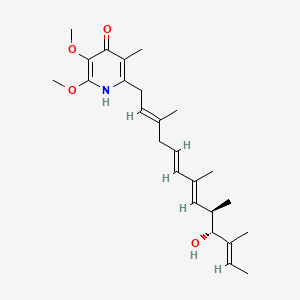Compound
D0294 | Piericidin A
| Toxicity | Dose | Time | Species | Model | Method | Action | Positive criterion | Reference |
|---|---|---|---|---|---|---|---|---|
| ELECTRON TRANSPORT CHAIN | affect | 53 | ||||||
| ELECTRON TRANSPORT CHAIN | 0.06 nmol/mg | bovine | mitochondria | NADH–Q | decrease | IC50 | 94 | |
| ELECTRON TRANSPORT CHAIN | 0.03 nmol/mg | bovine | mitochondria | NADH:O2 | decrease | IC50 | 94 | |
| Target | Dose | Time | Species | Model | Method | Action | Positive criterion | Reference |
|---|---|---|---|---|---|---|---|---|
| NADH:ubiquinone reductase | 0.06 nmol/mg | bovine | mitochondria | NADH–Q | inhibitor | IC50 | 94 | |
| NADH:ubiquinone reductase | 0.03 nmol/mg | bovine | mitochondria | NADH:O2 | inhibitor | IC50 | 94 | |
| quinone | antagonist | 53 | ||||||
| Pictogram | Signal | Statements | Precautionary Statement Codes |
|---|---|---|---|
 |
Danger |
Aggregated GHS information provided by 192 companies from 1 notifications to the ECHA C&L Inventory. Each notification may be associated with multiple companies. H300 (100%): Fatal if swallowed [Danger Acute toxicity, oral] H310 (100%): Fatal in contact with skin [Danger Acute toxicity, dermal] H330 (100%): Fatal if inhaled [Danger Acute toxicity, inhalation] Information may vary between notifications depending on impurities, additives, and other factors. The percentage value in parenthesis indicates the notified classification ratio from companies that provide hazard codes. Only hazard codes with percentage values above 10% are shown. |
P260, P262, P264, P270, P271, P280, P284, P301+P310, P302+P350, P304+P340, P310, P320, P321, P322, P330, P361, P363, P403+P233, P405, and P501; (The corresponding statement to each P-code can be found at the GHS Classification page.) |
| Organism | Test type | Route | Dose (normalized dose) | Effect | Source |
|---|---|---|---|---|---|
| mouse | LD50 | intraperitoneal | 870ug/kg (0.87mg/kg) | Agricultural and Biological Chemistry. Vol. 27, Pg. 576, 1963. | |
| rat | LDLo | intraperitoneal | 360ug/kg (0.36mg/kg) | Agricultural and Biological Chemistry. Vol. 34, Pg. 1101, 1970. | |
| mouse | LDLo | intravenous | 1mg/kg (1mg/kg) | Journal of Antibiotics. Vol. 40, Pg. 149, 1987. | |
| mouse | LD50 | skin | 2520ug/kg (2.52mg/kg) | Agricultural and Biological Chemistry. Vol. 32, Pg. 1115, 1968. | |
| mouse | LD50 | oral | 3170ug/kg (3.17mg/kg) | Agricultural and Biological Chemistry. Vol. 32, Pg. 1115, 1968. | |
| (+)-piericidin A1 | 2,6,9,11-Tridecatetraen-4-ol, 13-(4-hydroxy-5,6-dimethoxy-3-methyl-2-pyridyl)-3,5,7,11-tetramethyl-, (all-E)-(4R,5R)- | 2,6,9,11-Tridecatetraen-4-ol, 13-(4-hydroxy-5,6-dimethoxy-3-methyl-2-pyridyl)-3,5,7,11-tetramethyl-, (all-E)-(4S,5S)- |
| 2-(10-hydroxy-3,7,9,11-tetramethyl-2,4,7,11-tridecatetraenyl)-5,6-dimethoxy-3-methyl-4-pyridinol | 2-[(2E,5E,7E,11E)-10R-hydroxy-3,7,9R,11-tetramethyl-2,5,7,11-tridecatetraen-1-yl]-5,6-dimethoxy-3-methyl-4-pyridinol | 2-[(2E,5E,7E,9R,10R,11E)-10-hydroxy-3,7,9,11-tetramethyltrideca-2,5,7,11-tetraen-1-yl]-5,6-dimethoxy-3-methylpyridin-4-ol |
| 2-[(2E,5E,7E,9R,10R,11E)-10-hydroxy-3,7,9,11-tetramethyltrideca-2,5,7,11-tetraenyl]-5,6-dimethoxy-3-methyl-1H-pyridin-4-one | 2738-64-9 | 4-Pyridinol, 2-((2E,5E,7E,9R,10R,11E)-10-hydroxy-3,7,9,11-tetramethyl-2,5,7,11-tridecatetraenyl)-5,6-dimethoxy-3-methyl- |
| 4-Pyridinol, 2-(10-hydroxy-3,7,9,11-tetramethyl-2,5,7,11-tridecatetraenyl)-5,6-dimethoxy-3-methyl-, (R-(R*,R*-(all-E)))- | 8VT513UJ9R | ACon0_001227 |
| ACon1_001455 | AR 054 | BDBM50411905 |
| BRD-K73581776-001-01-6 | BRN 1555726 | CHEBI:138511 |
| CHEMBL272733 | DTXSID80880044 | J-016753 |
| LS-157163 | MEGxm0_000313 | NCGC00180489-01 |
| Piericidin | Piericidin A | Piericidin A from Streptomyces mobaraensis, >=90.0% (HPLC), liquid, green-yellow |
| Piericidin A from microbial source, >95% (HPLC), DMSO solution | Piericidin A1 | Piericidine A |
| Q7191888 | SCHEMBL18941698 | SCHEMBL19717606 |
| SN 198E | Shaoguanmycin B | UNII-8VT513UJ9R |
| ZINC14655907 |
| CAS Number | 19855-42-6, 2738-64-9 |
| PubChem Compound | 6437838 |
| ChEBI | 138511 |
| ChemSpider | 4942360 |
| Wikipedia | Piericidin A |

